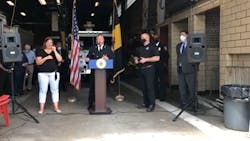New Alert System to Reduce Time, Stress for Pittsburgh FFs
By Megan Guza
Source The Tribune-Review
A new alert system installed across Pittsburgh’s firehouses will streamline responses and cut down on stress that wears on firefighters from listening to every call every moment they’re in the station, Public Safety officials said in introducing the system on Wednesday.
Dispatches are only heard by the station or stations that will be responding to the call, under the system.
Previously, every dispatch was heard in every room in every station.
Other emergency radio conversations and scanner chatter would also blare through each station’s speakers, Pittsburgh Bureau of Fire Lt. Dan Doyle said.
“Most of the people in the bureau would tell you it’s just part of the job, that’s what we get paid to do, it doesn’t affect me – I’m used to that,” Doyle said, speaking alongside other Public Safety and city officials outside Station 37 in the Manchester neighborhood.
Research shows that’s not true, he said.
“It raises your pulse rate, your body reacts to it even though you’re not going to be the one going on that call,” he said. “You kind of jump real quick to make sure before you arrive at the conclusion, ‘Oh, that’s not me,’ and you can go back about your business.”
“Twenty, 30, 40 years of that really packs a punch,” he said.
The technology comes from PURVIS, a Rhode Island-based company, and it has been used in a number of other cities for years, including New York City.
Public Safety Director Wendell Hissrich said he’d experienced the jarring dispatches himself when he was a city medic in the late 1980s.
“I sat many a times up at (Station 12) where, throughout the night, throughout the day, the radio was blaring,” Hissrich said. “It was very stressful, especially at night. You would jump out of your chair on a fire call because the intercom was so loud.”
When he came back to Pittsburgh 25 years later he was dismayed to find the very same alert system in place, Hissrich said.
A color-coded light system in each of the station’s rooms will let firefighters know before they even hear the call what it is – a building fire, a smoke alarm, a car fire, and so on. The speaker itself will start with a low tone and then get louder, and a light on the speaker specifically in the bunk room will light up slowly just enough for crews to see the way to their gear.
A hard copy of the call details will automatically print out, and the details will be displayed on a 60-inch LED board in each station. There are fail-safes in place that detect if there’s a problem in the system, which will then revert back to the alerts being broadcast to all stations, making it so no call is ever missed.
Chief Darryl Jones the new system will be vital to reducing unneeded stress on firefighters – and vital to getting crews out the door faster and with more information.
“Not only will it be more efficient as far as getting us out of the station… we get out of the station with more information,” he said.
Mayor Bill Peduto said the old system was once likened that from the 1970s television show “Emergency.”
“Utilizing that type of technology to save people’s lives and never changing it is not an investment in the people of the city of Pittsburgh,” he said. “That’s what this simply comes down to: a better informed firefighter, a better informed medic are able to save more people’s lives.”
Megan Guza is a Tribune-Review staff writer. You can contact Megan at 412-380-8519, [email protected] or via Twitter .
———
©2020 The Tribune-Review (Greensburg, Pa.)
Visit The Tribune-Review (Greensburg, Pa.) at www.triblive.com
Distributed by Tribune Content Agency, LLC.






